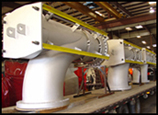| Type: | Fabric Expansion Joint |
| Size: | 143″ long x 61″ wide x 12″ face-to-face |
| Material: | PTFE Fiberglass Reinforced Fabric Belt & 304 Stainless Steel |
| Design: | -20°F to 600°F , +/- 100″ water column, 0.5″ Axial & 1″ Lateral |
| Testing: | Dye-Penetrant |
US Bellows fabricated this rectangular fabric expansion joint for an inlet duct application at a gas turbine facility. The unit is 143″ long x 61″ wide x 12″ face-to-face. The fabric belt is made from reinforced PTFE fiberglass and the frame and liner from 304 stainless steel. It is designed for an operating temperature ranging from -20°F to 600°F with a pressure of +/- 100″ water column, with 0.5″ of axial compression and 1″ of lateral deflection. A dye-penetrant examination was performed on all the structural frame welds prior to shipment.
Fabric expansion joints are used in a wide array of applications playing a crucial role in preventing damage to equipment, ensuring system reliability, and maintaining overall safety in industrial processes. Some examples of where they are used are:
-
- Cement plants for ducts and exhaust systems associated with high temperature operations.
-
- Mining industry for mineral and material handling including smelting.
-
- HVAC systems for duct work to address any thermal movements or vibrations.
-
- Marine and shipbuilding applications where exhaust systems, engine piping and other critical areas movement and vibrations must be managed.
-
- Renewable energy facilities such a waste to energy or bioenergy plants in which the incineration operations are critical.
-
- Paper and pulp mills for ducting systems in drying and paper manufacturing processes.
-
- Steel mills for blast furnace systems and exhausting ducts
-
- Chemical plants to handle dynamic forces associated with chemical reactions, temperature variations and corrosive environments.
- Power plants: Fossil fuel and nuclear plants to manage vibrations and thermal axial expansion that could stress components and fixed equipment.
PT&P REF. ORIGINAL POST 06252018




